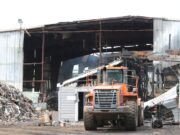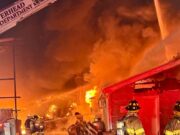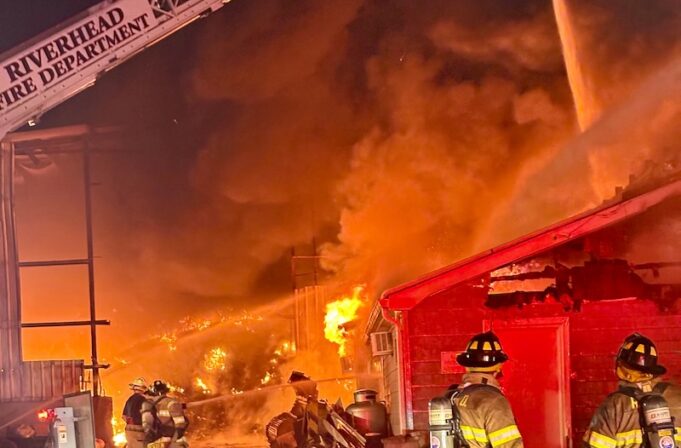We can’t let this week go by without expressing deep gratitude for the first responders from across the region who fought the massive fire at Crown Recycling in Calverton.
The speed of their response and the professionalism and precision with which they came together to fight that dangerous blaze for some 12 hours Wednesday should drive home for all of us how fortunate we are to have brave men and women of their caliber and dedication willing to show up at 2 a.m. to defend lives and property in the face of potential disaster.
Riverhead Council Member Ken Rothwell, a Wading River Fire Department volunteer who was on scene for the duration of the incident, spoke to RiverheadLOCAL Wednesday afternoon of his admiration for the way Riverhead Fire Department handles these situations. The coordination of RFD’s response and their communication with other first responders is second to none, he said. And in emergencies, especially in incidents like the one at the recycling plant this week, every minute counts.
We believe the same can be said for the Riverhead Police Department, particularly in their response to an emergency like the one in Calverton Wednesday. Under the leadership of Chief Ed Frost, Capt. Danielle Willsey and the rest of the department brass, Riverhead’s finest are at the top of their game — and it shows.
The emergency medical services departments that stand ready to treat any injuries and rush patients to the appropriate medical facilities also play a crucial role in handling incidents that can easily become major disasters for responding firefighters. Fortunately, thanks to the response of more than 30 fire departments, led and coordinated at the scene by RFD chiefs, there were no serious injuries to treat.
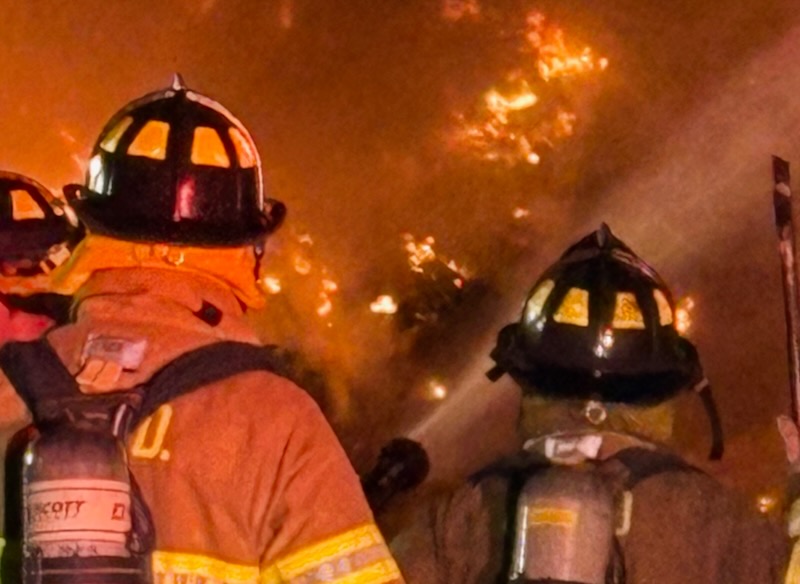
What burned in Wednesday’s blaze?
When a blaze breaks out at a recycling plant or any waste transfer facility, emergency responders simply never know what they are going to encounter on scene, potentially including extremely flammable and explosive materials. The garbage trucked to such a facility, where it’s sorted, baled and stored for a period of time, is a mix of all kinds of materials, some of which are potentially toxic when burned — even everyday household items that contain vinyl and plastics.
A plant like Crown’s, which has a state permit to handle and recycle asbestos —and store up to 185 cubic yards of asbestos materials on site for up to 10 days — presents special dangers, not only to firefighters but also to surrounding residents.
Residents who saw the large plume of smoke in the sky as the fire raged out of control Wednesday morning and smelled the acrid odor in the air were justifiably frightened and looking for information — and guidance. It was in short supply.
We fielded numerous calls and text messages beginning at about 5 a.m. Wednesday asking what was happening and whether the air was safe to breathe. Would it be safe to allow their children to wait on street corners for school buses? Should they close all the windows?
Information from Suffolk County Fire and Emergency Services, which handles public communications about emergencies, was slow to come and minimal. Suffolk FRES relies on a text messaging service that is supposed to send alerts to subscribers. What about people who haven’t subscribed? Or people who don’t have cell phones to receive text messages? Or people who subscribed but changed their phone numbers?
I personally signed up for Suffolk emergency alerts when the service was announced years ago. Despite residing within two miles of this fire, I never got an alert about it. In fact, it turned out I hadn’t gotten any alerts from the messaging system since 2023, when a text arrived advising of a “controlled burn” in the area of Whiskey Road in Ridge. (My cell number has been the same for about 20 years.)
I’ve been contacted by people who live even closer to the scene who also never got an alert. Other people I spoke to got a text message at around 7 a.m. advising them to close their windows due to a fire in the area. Nothing more. FRES also posted the same notice at about that time on its Facebook page.
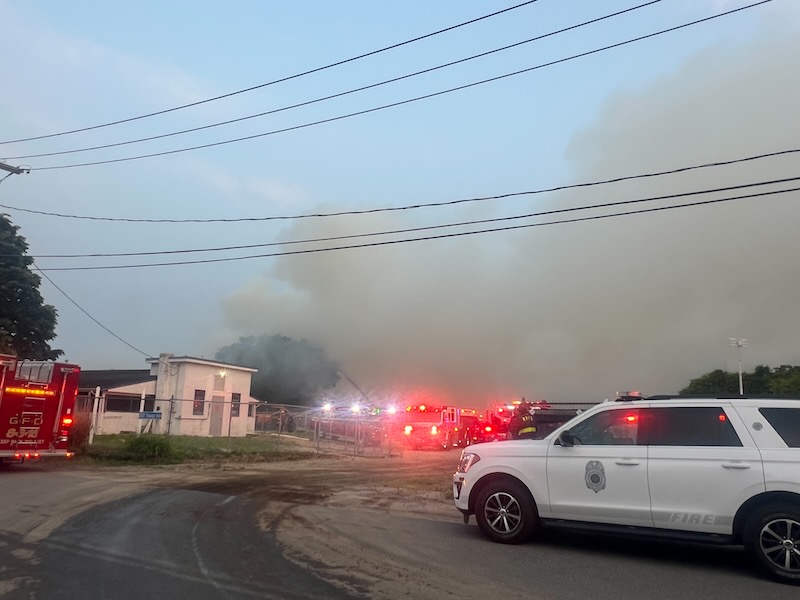
It’s perplexing that FRES doesn’t send an email advisory to the media so that vital information in an emergency can be efficiently disseminated far and wide. With the press of a button an emergency alert would be amplified and widely broadcast to the people who needed it most, almost instantly. The text system is a cool innovation, but it’s not enough by itself and social media algorithms are unreliable.
The agency’s primary responsibility is coordinating the countywide response to an emergency, but protecting public health by providing vital information to the public should not be an afterthought. Is there another agency that could help with this task —maybe the Suffolk County Police Department’s public information office, which already has a staff that can efficiently handle this duty, including after regular business hours?
We appreciate Riverhead Police Chief Ed Frost for being accessible and communicative during this event. It seemed that he, too, had limited information early on.
The assistant regional director of the State Department of Environmental Conservation said at a press conference across from the still-smoldering and smoking site Wednesday afternoon that “preliminary reports” indicate there was no asbestos at the site when the blaze broke out. He did not explain the source of those preliminary reports. We sure hope those preliminary reports were accurate.
When asbestos materials burn, asbestos fibers can be released into the air and can remain airborne for 48 to 72 hours or longer. If inhaled, asbestos fibers can cause major health problems, including lung cancer, mesothelioma, and asbestosis.
As of Wednesday afternoon, DEC investigators had not yet been able to access the rubble for samples or tests and it was still unclear whether any records required to be maintained by the facility had survived the blaze. State regulations allow those records to be stored on site and rather than in an off-site database. Crown’s facility manual, filed with the DEC, state those records will be stored onsite. If the onsite records are destroyed in a fire, an immediate, effective response to any public health threat is obviously impeded.
We hope the DEC thoroughly investigates the scene as well as all available records from every source to determine what went up in flames at Crown in the wee hours of the morning Wednesday. The results of that investigation would come too late to address air quality issues during the fire or immediately afterwards. But a quick and thorough investigation is the only way to ensure the safe handling and disposal of the materials that remain at the site. This is essential for obvious reasons.
And the DEC must be transparent about its findings. There’s plenty of reason to be skeptical, starting with assurances by various authorities in the aftermath of the World Trade Center attack in 2001 that the air was safe and the rubble at Ground Zero was not toxic. Too many people suffered and died — and are still suffering and dying— as a result of those assurances.
Plenty of questions remain. We learned Wednesday that there were no air monitoring stations at or around the site. Shouldn’t some kind of outdoor air monitoring systems be mandated for all waste handling facilities of this nature? Did the state and county health departments mobilize to do immediate air testing? Did town officials demand this?
None of these questions or concerns should be interpreted as in any way tarnishing the response of our brave first responders who handled this incident impeccably. After all, working on the front lines as they do, it’s their health and their lives that are always most immediately at stake. They are the ones who always pay the steepest price — another lesson September 11 taught us.

Garbage is never really thrown ‘away’
Finally, this incident is no reason to demonize the people who collect, sort and handle our trash. There are certainly issues with the location of the Crown facility, established at a time when the town dump was operating across the street — but now surrounded by many residential developments. These issues have caused frustration and anger among residents in the surrounding community, resulting in complaints about heavy truck traffic, odors, exhaust fumes from idling tractor-trailers and more.
But none of us should forget that it’s our trash being picked up, sorted on a conveyor belt, separated, baled and long-hauled to distant facilities for further processing and “disposal.”
The word “disposal” deserves quotation marks to remind us that, when it comes right down to it, there is no “away” into which we can simply throw our garbage. Every disposal method has impacts — impacts to our pocketbooks, our environment and our quality of life. For people who live near waste facilities these impacts are an unavoidable daily reality. Others have the temporary luxury of simply putting out the trash without giving it a second thought.
The survival of local journalism depends on your support.
We are a small family-owned operation. You rely on us to stay informed, and we depend on you to make our work possible. Just a few dollars can help us continue to bring this important service to our community.
Support RiverheadLOCAL today.












